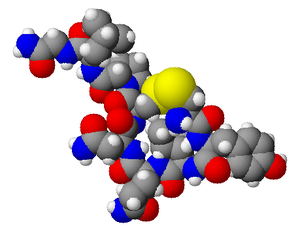 |
| Spacefilling model of oxytocin. Created using ACD/ChemSketch 8.0, ACD/3D Viewer and The GIMP. (Photo credit: Wikipedia) |
And scammers know exactly what button to push to get you to believe that they needed help from you... And somehow you'll gain something from it. But you won't get anything back. Whatever help you offered is gone. That was the con.
In a "pigeon drop" con, the "mark" (intended victim) was convinced to give up an amount of money or valuable object in hopes of bigger amount of money, usually by claiming some sort of reward, time limit, and so on. A typical example goes like this... At a gas station, one guy comes up to the gas station attendant, claimed to have found this pearl necklace in the restroom, "must be worth a fortune!" Then a call comes in... the guy's wife lost the necklace there did any one see it, and he's offering a $200 reward, and he'll be there in 30 minutes. The guy offers to "sell" the necklace to the attendant for $100, because he was running late.
As you can guess, there was no reward. The attendant was out $100 bucks, and the "pearl" necklace is a plastic fake worth a few dollars at best. The attendant (i.e. the "mark") was persuaded by two things: 1) the need to "help" the guy who want the necklace back, AND 2) the need to help the guy who "found" the necklace, but had to leave for work ASAP. Neither story can be verified, and time pressure prevents any verification. The oxytocin kicked in and made you trust the two conmen because they appear to be "vulnerable".
A very similar scenario happens in the "secret shopper" scam, where the mark was convinced to give up money in hopes of bigger amounts of money. Let's say you were enticed into joining this secret shopper program, where you're supposed to be given a check to do some shopping a particular store, in order to "test" the employees. When the check arrived, it was twice you expect. And you get a frantic call from your contact (over the phone, never in person) that she had screwed up, she sent you someone else's check too, and if her boss found out she will be fired. You need to transfer the money back to her IMMEDIATELY to "help her out" so she can put the money back into the account, but you can spend the double-sized check (all at the same store as usual). The transfer will probably be via Western Union or MoneyPak which only requires a name and a pickup number, untraceable.
As you may imagine, the "check" you got is a fake, but the money you transferred to "her" is real. Furthermore, you're the one in trouble because it is YOU who passed a bad check at the bank, not the other perp. You felt compelled to help and you can't verify the story due to this fake time pressure (which also cannot be verified). Your oxytocin system was engaged to make you fall for a "con".
Oxytocin is not all powerful. It engages your emotional center, your "connection maker / interpreter", but your prefrontal cortex, your "logic processor", moderates the oxytocin influence on your brain. It is when you have an imbalance between the two, when you have a makings of a victim, or a conman.
A conman, who seriously lack oxytocin, does NOT reciprocate. In other words, s/he seems to have little or no sympathy or empathy, a lot like a sociopath. If you give one money, and expect him/her to give it back, s/he'll keep the money, then tell you it's your fault to trust him/her with the money. Yet somehow they can simulate vulnerability and thus induce OTHER PEOPLE to have oxytocin reactions.
A victim, on the other hand, has too much oxytocin and/or less prefrontal cortex that allows the logic processor to override the emotional actions caused by oxytocin, thus letting emotions do all the work, no logic is needed.
Yet much of scam (and a lot of MLM) is based on appeal to emotion, "go all in", "go for broke", "go big or go home", "avoid negativity", "fake it till you make it"... all these are cited over and over by various "coaches" and "speakers" and such.
They want you to engage your oxytocin system (esp. through MLM, which relies on social interactions), and hope you have a weak prefrontal cortex logic processor that will fail to override the oxytocin system, thus act upon whatever narrative they wish to convince you of, and that is how you get conned.
http://www.psychologytoday.com/blog/the-moral-molecule/200811/how-run-con




No comments:
Post a Comment